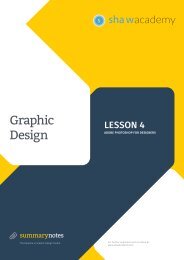GD Toolkit Summary Notes - Lesson 6
Create successful ePaper yourself
Turn your PDF publications into a flip-book with our unique Google optimized e-Paper software.
S<br />
shawacademy<br />
Graphic<br />
Design<br />
LESSON 6<br />
LOGO DESIGN<br />
summarynotes<br />
The Diploma in Graphic Design <strong>Toolkit</strong><br />
For further questions visit us online at:<br />
www.shawacademy.com
S <strong>Lesson</strong> 6<br />
S<br />
shawacademy
S <strong>Lesson</strong> 6<br />
WE BEGIN WITH THE<br />
“WHAT IS” OF GRAPHIC<br />
DESIGN AND HOW<br />
GRAPHIC DESIGN IS ALL<br />
ABOUT VISUALLY COM-<br />
MUNICATING AN IDEA,<br />
THOUGHT, MESSAGE OR<br />
MEANING BY COMBINING<br />
SYMBOLS, IMAGES AND/<br />
OR WORDS. WE ALSO<br />
GIVE AN OVERVIEW OF<br />
THE “HOLY TRINITY”<br />
OF GRAPHIC DESIGN<br />
APPLICATIONS -<br />
ADOBE PHOTOSHOP,<br />
ILLUSTRATOR &<br />
INDESIGN AND HOW<br />
DESIGNERS BEST USE<br />
THESE TOOLS.<br />
1.01 Understanding Colour 4<br />
1.02 Colour Trends & Codes 6<br />
1.03 Logo Design Process 9<br />
1.04 Logo Design Principles 10
S<br />
Understanding Colour<br />
Colour is<br />
the most<br />
influential<br />
element of<br />
our natural<br />
senses,<br />
followed<br />
by Shapes,<br />
Symbols<br />
and lastly<br />
Words.
S<br />
Understanding Colour<br />
Colour plays a major part in the correct reflection<br />
of your brand.<br />
Graphic Design is<br />
“the art or<br />
profession of visual<br />
communication that<br />
combines images,<br />
words and ideas to<br />
convey information<br />
to an audience”<br />
Design must<br />
be interpreted<br />
the same way<br />
by everyone<br />
to function.<br />
This visually obvious yet subtle application has a<br />
significant impact on the way a brand is perceived<br />
by the public.<br />
Colour does not discriminate!<br />
No matter if you’re designing a brand for yourself,<br />
a small company, or a corporation the effects of<br />
colour will not discriminate based on how much<br />
cash you have to start.<br />
When looking at colour options for your brand it’s<br />
always best to take a look at other brands to get<br />
a clear idea on how colour schemes play a part on<br />
the perception of brand perception.
S<br />
Colour Trends<br />
Colour can<br />
increase brand<br />
recognition<br />
by up to 80%.
S<br />
Colour Trends<br />
1.02<br />
Colour Trends<br />
A study of the world’s top 100 brands<br />
(as determined by brand value)<br />
analysed each brand’s logo and found<br />
the following trends.<br />
33% use Blue<br />
29% use Red<br />
27% use Black or Grayscale<br />
11% use Yellow<br />
95% use only 1 or 2 colours<br />
5% use more than 2 colours<br />
41% use text only<br />
9% don’t feature a company name<br />
Colour can increase brand recognition by up to 80%.<br />
This means that colour influences how customers view<br />
the personality of the brand.<br />
Our brains prefer recognisable brands,<br />
which makes colour a key factor in creating<br />
brand identity.
S<br />
Colour Codes<br />
As Dainis Graveris has written once, “sketching isn’t time-consuming and is a really<br />
good way to put ideas in your head right on paper. After that, it’s always easier to<br />
actually design it on the computer. Sketching helps to evolve your imagination: once<br />
you understand it, you will always start from just white paper.<br />
Black is used by companies wishing to evoke a classic sophistication and simplicity. Black works<br />
especially well for brands wishing to promote luxury.<br />
Code: Prestige, Value, Timelessness, Sophistication, Formality<br />
Red evokes a passionate and visceral response. It increases your heartrate, makes you breathe<br />
more heavily and activates the pituitary gland.<br />
Code: Aggression, Energy, Proactive-ness, Passion, Power<br />
Yellow communicates hope and optimism. Yellow stimulates creativity and energy, and its<br />
brightness is particularly useful in catching the customer’s eye.<br />
Code: Positivity, Light, Warmth, Creativity, Motivation<br />
Blue is the most common colour used in brand creation. It’s thought to put people at ease.<br />
Code: Trustworthiness, Dependability, Security, Integrity, Calmness<br />
Green is synonymous with calm, freshness and health. With great variance in shades, deeper<br />
greens are associated with affluence, lighter shades with serenity.<br />
Code: Wealth, Health, Serenity, Prestige, Abundance<br />
Purple is a mysterious yet sophisticated colour. The richness of this colour tips its hat to elegance,<br />
a colour used to symbolise royalty throughout history.<br />
Code: Royalty, Sophistication, Nostalgia, Mystery, Spirituality<br />
Pink is a feminine and affectionate colour, that lends itself to identifying products and services<br />
geared towards women and young girls.<br />
Code: Tenderness, Sensitivity, Friendship, Beauty<br />
Orange combines the brightness and cheer of yellow with the energy and boldness of red to make<br />
a colour that is full of life and exudes plenty of excitement.<br />
Code: Vitality, Fun, Playfulness, Exuberance, Youthfulness Compassion
S<br />
Misconceptions about Graphic Design<br />
1.03<br />
Logo Design Process<br />
When creating a logo, follow a<br />
process that ensures the final<br />
design meets the needs of the<br />
clients.<br />
Here you see the typical<br />
process that professional logo<br />
designers follow.<br />
With practice, you will develop<br />
your own.<br />
“Some wonder what’s so difficult about creating a good logo. They’re<br />
small, they look easy to do, so no problem, right? When you only see<br />
the result of a designer’s efforts, the logo creation can look like it was<br />
a simple task. But it’s not. A logo takes thought and creativity, and<br />
many elements combine to make a good one.” - Harrison Mcleod<br />
Design Brief - Conduct a questionnaire or interview with the client to<br />
get the design brief.<br />
Research - Conduct research on the industry itself, its history and<br />
competitors. Problem-solve first, design later.<br />
Reference - Conduct research on logo designs that have been<br />
successful and on current styles and trends that may relate to the<br />
design brief. Follow trends not for their own sake but rather to be<br />
aware of them: longevity in logo design is key.<br />
Sketching and Conceptualizing - Develop the logo design<br />
concept(s) around the brief and your research. This is the single most<br />
important part of the design process. Get creative and be inspired.<br />
Reflection - Take breaks throughout the design process. This helps<br />
your ideas mature, renews your enthusiasm and allows you to solicit<br />
feedback. It also gives you a fresh perspective on your work.<br />
Revisions and Positioning - Whether you position yourself as<br />
a contractor (i.e. getting instructions from the client) or build a<br />
long-lasting relationship (i.e. guiding the client to the best solution),<br />
revise and improve the logo as required.<br />
Presentation - Present only your best logo designs to your client.<br />
PDF format usually works best. You may also wish to show the logo<br />
in context, which will help the client more clearly visualize the brand<br />
identity. Preparing a high-quality presentation is the single most<br />
effective way to get your clients to approve your designs.<br />
Delivery and Support - Deliver the appropriate files to the client<br />
and give all support that is needed. Remember to under-promise and<br />
over-deliver.
S<br />
Principles of Effective Logo Design<br />
A good logo<br />
is distinctive,<br />
appropriate,<br />
practical, graphic<br />
and simple in<br />
form, and it<br />
conveys the<br />
owner’s intended<br />
message.
S<br />
Principles of Effective Logo Design<br />
1.04<br />
Logo Design Principles<br />
Simple Simplicity makes a logo design easily recognizable, versatile and memorable. Good<br />
logos feature something unexpected or unique, without being “overdrawn.”<br />
K.I.S.S. Principle of design, which translates as: Keep It Simple, Stupid. It does convey a very<br />
important design consideration. Simple logos are often easily recognised, incredibly memorable<br />
and the most effective in conveying the requirements of the client.<br />
Memorable Following closely on this principle of simplicity is that of memorability. An<br />
effective logo design should be memorable, which is achieved by keeping it simple yet appropriate.<br />
Timeless An effective logo should be timeless. Will yours stand the test of time? Will it still<br />
be effective in 10, 20 or 50 years?<br />
Versatile An effective logo works across a variety of media and applications. For this<br />
reason, logos should be designed in vector format, to ensure that they scale to any size.<br />
Ask yourself, is your logo still effective if it is printed. In one colour? In reverse colour (i.e. light logo<br />
on dark background)? The size of a postage stamp? As large as a billboard?<br />
One way to create a versatile logo is to begin designing in black and white. This allows you to focus<br />
on the concept and shape, rather than colour, which is subjective in nature. Also keep in mind<br />
printing costs: the more colours you use, the more expensive it will be for the business over the<br />
long term.<br />
Appropriate How you “position” the logo should be appropriate for its intended audience.<br />
For example, a child-like font and colour scheme would be appropriate for a logo for a children’s toy<br />
store, not so much for a law firm.
S







